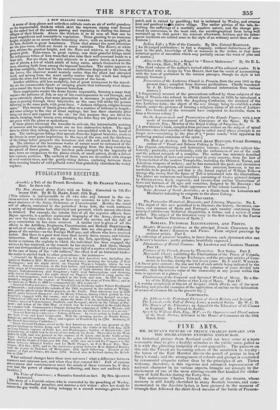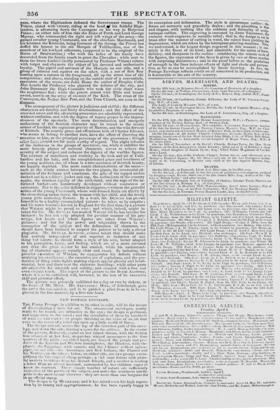FINE ARTS.
MR. DUNCAN'S PICTURE OF PRINCE, CHARLES EDWARD AND TilE Duilit.ANDERS ENTERING EDINBURGH.
AN historical picture front Scotland could not have come at a more seasonable time to give a healthy stimulus to the public taste, palled as it is with the glittering insipidity of court pageantry. The painters on this side the Tweed are becoming ushers of the maulstick to royalty : the baton of the Earl Marshal directs the pencil of genius in lieu of fituey's wand ; and the arrangement of colours and groups is controlled by ceremonial etiquette rather than by the principles of art. Thrice welcome, therefore, is this vigorous and animated representation of national character in its various aspects, brought out strongly by the excitement of one of the most stirring event's that kindled the enthu- siasm of Auld Heckle during the Forty-five. The unfortunate Charles Edward, the last of the Stuarts, whose memory is still fondly cherished in many Scottish bosoms, and com- memorated in the Jacobite lyrics, is here pictured in the moment of triumph that followed the short-lived success of the battle of Preston- pans, where the Highlanders defeated the Government troops. The Prince, elated with victory, riding at the head of his faithful High- landers, is advancing down the Canongate on his way to Holyrood Palace ; on either side of him ride the Duke of Perth and Lord George Murray, who commanded the right and left wings of the army—the gallant cavalier young Clanranald, son of the chieftain Macdonald, and kis kinsmen the Kinlochs, being foremost of the throng: the Prince has doffed his bonnet to the old Marquis of Tullibardine, one of the stanchest of his lowland adherents, (supposed to be the original of the Baron of Bradwardine,) NVTIO with the ladies of his family have descended from the family coach to greet the Chevalier; while near to them the brave Lochiel (nobly personated by Professor Wilson) salutes with target and claymore the object of his devoted and enthusiastic loyalty. The pipers and servants of the Marquis on one side, and a group of citizens and squires on the other, with a son of Rob Roy leaning upon a cannon in the foreground, fill up the street line of the composition ; and above, standing on the outside stair of a conventicle, spectators of the scene, are John Home the author of Douglas, Cohn Mac Laurin the Professor who planned the defence of the city, and John Dunsmuir the High Constable who took the civic chair when the magistrates fled ; while the pastor, armed with Bible and broad- sword, scowls on the array of enemies of the Kirk. The cross of the Canongate, the Nether Bow Port, and the Tron Church, are seen in the distance.
The arrangement of the picture is judicious and skilful; the different characters are forcibly and finely discriminated ; and the effect of the crowded street and the advancing procession are admirably represented, without confusion, and with the degree of repose proper to the impres- siveness of the spectacle. The stern determination and energetic enthusiasm of the Scottish character may be traced in the manly ardour of Loehiel, the sagacious gravity of Murray, and the wild fervour of Kinloch. The courtly grace and effeminate look of Charles Edward, who seems to belong to another race, have the effect of directing the ' attention to him, as the principal personage of the procession ; though iasr faaas around are far =ore worthy of regard. The slight infusion of the ludicrous in the groups of spectators, too, while it exhibits the more homely phases of national character, serves to relieve the severity of the subject and enhance the dignity of the warlike figures. The mixture of stateliness and rusticity in the look and air of Tulli- bardine and his lady, and the unsophisticated grace and loveliness of the young maidens, one of whom is a rare specimen of Scottish beauty, are happily depicted. The more comic characteristics of the scene— such as the windy contest between the two pipers, the reverential ad- miration of the footman and coachman, the glee of the ragged urchin decked out in a soldier's jacket and cap, the enthusiasm of the country squire, the drunken loyalty of the cock-laird, and the rage of the in- furiated barber—are humorously developed without coarseness or caricature. Nor is the artist deficient in elegance,—witness the graceful action of the young Clanranald, whose well-formed limbs are shown by the close-fittiug tartan trews, the woman with her child, and the lovely
young girls scattering flowers. In a word, Mr. DUNCAN has proved himself to be a highly-accomplished painter : he takes us by surprise ; and his name becomes known in England for the first time, by a picture that WILKIE might he proud to own ; and which, indeed, might be taken for his. Mr. DrscAN has studied WILKIE till he has become his imitator : he has not enly adopted the peculiar manner of his pro- totype, but heads and whole figures are taken from Wimun's pictures ; and but for the power and originality shown in the conception of the subject and the delineation of character, we should have been inclined to suspect the painter to be only a clever plagiarist. Mr. DUNCAN, however, evinces talent that should make him entirely independent of and superior to imitation of any thing but nature: he should form a style of his own, better adapted to his perception, fancy, and feeling, which are of a more elevated cast than the great muster he has studied, while his understand- ing of character appears equally clear and exact. In imitating the peculiar execution of \Vim:1E, he exaggerates his defects without attaining his excellences : the excessive use of asphaltum, and the pro- duction of filmy white lights, making objects appear ghostly and insub- stantial, here and there mar the elaborate handling ; while other parts are admirable for strength and solidity, and coupled with a free and even elegant touch. The aspect of the picture hi the Royal Academy, where it is to be exhibited, will, however, be time test of its executive skill and pictorial effect.
The picture was privately exhibited for a day or two by tickets, at the house of Mr. Moos. Mr. ALEXANDER HILL, of Edinburgh, gave the artist the commission, and is to publish a print from it, to be en- graved in the line manner, by a first-rate hand.



























 Previous page
Previous page